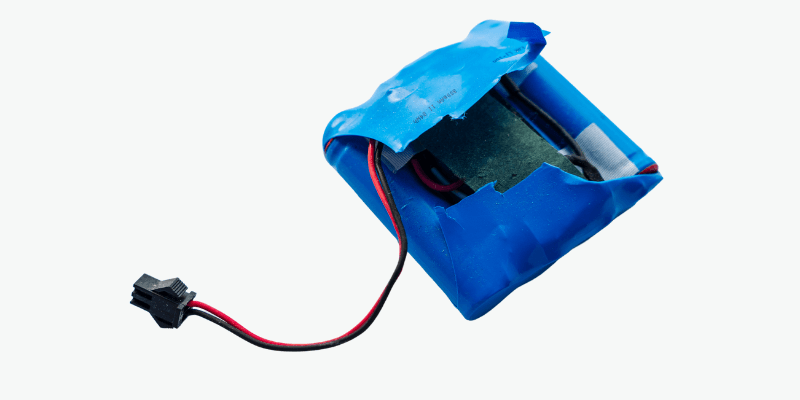ประเด็นสำคัญ:
- ระบุความล้มเหลวของแบตเตอรี่ลิเธียมไอออนด้วยสัญญาณต่างๆ เช่น เวลาชาร์จนานขึ้น ร้อนเกินไป และบวม ใช้เครื่องชาร์จที่มีคุณภาพและจัดเก็บแบตเตอรี่อย่างเหมาะสมเพื่อยืดอายุการใช้งาน
ความเสี่ยงของ แบตเตอรี่ลิเธียมไอออน อุบัติเหตุลดลงตามเทคโนโลยีที่ได้รับการปรับปรุง อย่างไรก็ตาม ปัญหายังคงเกิดขึ้นได้
หลายคนสนใจที่จะระบุแบตเตอรี่ลิเธียมไอออนที่ผิดปกติ ซึ่งอาจแสดงอาการต่างๆ เช่น ความจุลดลง แรงดันไฟฟ้าต่ำ การคายประจุเองอย่างรวดเร็ว ร้อนเกินไป และบวม
บทความนี้จะกล่าวถึงวิธีการตรวจสอบความล้มเหลวของแบตเตอรี่ลิเธียมไอออน
สาเหตุของความล้มเหลวของแบตเตอรี่ลิเธียมไอออน
แบตเตอรี่ลิเธียมไอออนแม้จะมีการป้องกัน BMS แต่ยังคงมีความเสี่ยงต่อปัจจัยภายในและภายนอกที่อาจทำให้เกิดความล้มเหลวได้
ภายใน การผลิต ปัญหาต่างๆ เช่น การเซาะราคา วัสดุที่ไม่ได้มาตรฐาน และการผลิตที่เลอะเทอะ อาจทำให้ความทนทานและประสิทธิภาพลดลงได้
ภายนอก สภาพแวดล้อม เช่น อุณหภูมิ ความชื้น ความกดอากาศ และความเครียดทางกายภาพ อาจส่งผลเสียต่อความสมบูรณ์ของแบตเตอรี่เมื่อเวลาผ่านไป
สัญญาณทั่วไปแบตเตอรี่ลิเธียมไอออนไม่ทำงาน
แบตเตอรี่ลิเธียมไอออนของคุณไม่ได้คงอยู่ตลอดไป แต่มีสัญญาณบางอย่างที่บ่งบอกว่าแบตเตอรี่กำลังจะพัง
1. เวลาในการชาร์จนานขึ้น
การชาร์จที่ช้าลงแสดงว่าแบตเตอรี่ของคุณกำลังสูญเสียความจุและไม่สามารถเก็บประจุไว้ได้นาน
นี่เป็นสัญญาณเริ่มต้นว่าแบตเตอรี่ลิเธียมไอออนของคุณทำงานล้มเหลว เนื่องจากแบตเตอรี่เหล่านี้จะค่อยๆ สูญเสียการกักเก็บพลังงานและประสิทธิภาพเมื่อเวลาผ่านไป
2. อายุการใช้งานแบตเตอรี่สั้นลง
อัตราการคายประจุที่รวดเร็วเป็นสัญญาณเริ่มต้นของความเสียหายของแบตเตอรี่ลิเธียมไอออน
หากแบตเตอรี่ของคุณจำเป็นต้องชาร์จใหม่บ่อยครั้ง อาจบ่งบอกว่าแบตเตอรี่เสื่อมสภาพและจำเป็นต้องเปลี่ยนใหม่
3. ความร้อนสูงเกินไป
ความร้อนที่มากเกินไประหว่างการใช้แบตเตอรี่หรือการชาร์จเป็นเรื่องที่น่ากังวล
ความร้อนบางส่วนเป็นเรื่องปกติ แต่อุณหภูมิที่เพิ่มขึ้นผิดปกติอาจบ่งบอกถึงปัญหาภายใน
ตรวจสอบการเพิ่มขึ้นของความร้อนที่เห็นได้ชัดเจน เนื่องจากความร้อนสูงเกินไปส่งผลต่อประสิทธิภาพการทำงานและก่อให้เกิดความเสี่ยงด้านความปลอดภัย
ความร้อนที่มากเกินไปอาจนำไปสู่ หนีความร้อนโดยที่อุณหภูมิสูงขึ้นอย่างต่อเนื่องทำให้อุปกรณ์ร้อนจนเป็นอันตราย นี่เป็นการส่งสัญญาณว่าแบตเตอรี่จำเป็นต้องได้รับการตรวจสอบอย่างใกล้ชิด
4. ไม่สามารถเรียกเก็บเงินได้
แบตเตอรี่หมดเป็นปัญหาที่พบบ่อยสำหรับผู้ใช้อุปกรณ์อิเล็กทรอนิกส์แบบพกพา
เมื่ออุปกรณ์ไม่ชาร์จ อาจบ่งบอกว่าแบตเตอรี่กำลังจะหมดซึ่งจำเป็นต้องเปลี่ยนใหม่
5. การปิดเครื่องโดยไม่คาดคิด
เมื่ออุปกรณ์ปิดกะทันหันทั้งที่แบตเตอรี่มีอายุการใช้งานเพียงพอ ก็มักจะบ่งชี้ว่าแบตเตอรี่ลิเธียมไอออนชำรุด
หากยังคงอยู่ ควรเปลี่ยนแบตเตอรี่โดยผู้เชี่ยวชาญ
6. ตัวบ่งชี้แบตเตอรี่ไม่ถูกต้อง
แม้ว่ามิเตอร์แบตเตอรี่จะเต็ม อุปกรณ์ต่างๆ ก็ยังอาจตายโดยไม่คาดคิดได้ ซึ่งบ่งชี้ว่าแบตเตอรี่ชำรุดซึ่งจำเป็นต้องเปลี่ยนใหม่
7. เวลาตอบสนองไม่ดี
เวลาตอบสนองที่ไม่ดีของอุปกรณ์อาจบ่งบอกว่าแบตเตอรี่อ่อน หรืออาจเป็นผลมาจากข้อมูลล้นเกินหรือปัญหาซอฟต์แวร์
8. แรงดันไฟฟ้าต่ำ
แบตเตอรี่จะค่อยๆ สูญเสียแรงดันไฟฟ้าเมื่อเวลาผ่านไป
เมื่อตรวจพบแรงดันไฟฟ้า วงจรตัดไฟจะตัดการเชื่อมต่อแบตเตอรี่ทันที
ตัวอย่างเช่น แบตเตอรี่ลิเธียมไอออน 4.2V อาจเปลี่ยนเป็น 3.7V หลังจากชาร์จและคายประจุซ้ำหลายครั้ง
อุปกรณ์หยุดทำงานเมื่อแบตเตอรี่ลดลงต่ำกว่า 3.4V และไม่สามารถใช้งานได้ที่ 3.0V
9. ความถี่สูงของการปลดปล่อยตัวเอง
แบตเตอรี่จะสูญเสียประจุในที่สุดเมื่อไม่ได้ใช้งาน
แบตเตอรี่ลิเธียมไอออนคุณภาพสูงมีอัตราการคายประจุเองต่ำ
ถอดแบตเตอรี่ออกหลังจากผ่านไปสองชั่วโมง และตรวจสอบระดับการชาร์จก่อนถอดปลั๊ก
หากค่าที่อ่านได้อยู่นอกช่วงที่ระบุ ถือว่าแบตเตอรี่ชำรุด
10. อาการบวมหรือโป่ง
การบวมหรือนูนในปลอกแบตเตอรี่บ่งบอกถึงปัญหาภายใน
แบตเตอรี่ที่มีรูปร่างผิดปกติจะส่งสัญญาณถึงความล้มเหลวและความเสี่ยงด้านความปลอดภัย รวมถึงการรั่วไหลหรือการระเบิด
การบวมเกิดขึ้นเนื่องจากการสะสมของก๊าซจากส่วนประกอบภายในที่ชำรุดหรือเสียหาย ทำให้แบตเตอรี่ขยายตัว
การแก้ไขปัญหาแบตเตอรี่ลิเธียมไอออน
ทดสอบแบตเตอรี่ลิเธียมไอออนของคุณทันทีหากคุณสงสัยว่าแบตเตอรี่ทำงานผิดปกติ
ปัญหาเช่นไฟไหม้อาจเกิดจากแบตเตอรี่ชำรุด ใช้มัลติมิเตอร์เพื่อทดสอบแบตเตอรี่

นำออกจากกล่องแล้วเชื่อมต่อสายบวกและลบของมัลติมิเตอร์เข้ากับขั้วแบตเตอรี่ เปิดมัลติมิเตอร์แล้วเปิดใช้งาน “แรงดันไฟฟ้ากระแสตรง” โหมด. วางโพรบบนเทอร์มินัลแล้วอ่านผลลัพธ์
แบตเตอรี่ลิเธียมไอออนที่เสียหายอาจแสดงแรงดันไฟฟ้าต่ำกว่าระดับปกติ 3.7V เช่น 3.5V หรือน้อยกว่า
ตรวจสอบความจุของแบตเตอรี่โดยการคายประจุจนหมดและอ่านค่าใหม่ – แบตเตอรี่ที่เสียหายจะมีพลังงานน้อยลง
เปลี่ยนแบตเตอรี่ลิเธียมไอออนโดยเร็วที่สุดหากคุณสงสัยว่าเกิดความเสียหาย การใช้แบตเตอรี่ที่เสียหายต่อไปไม่คุ้มกับความเสี่ยง
6 วิธีในการยืดอายุแบตเตอรี่ลิเธียมไอออน
1. ใช้เครื่องชาร์จคุณภาพสูงที่ผลิตขึ้นสำหรับแบตเตอรี่ลิเธียมไอออนเพื่อหลีกเลี่ยงการลดอายุการใช้งานแบตเตอรี่
2. หลีกเลี่ยงการชาร์จมากเกินไป – อย่าทิ้งแบตเตอรี่ไว้ค้างคืนเว้นแต่จำเป็น
3. อย่าคายประจุแบตเตอรี่มากเกินไป ตั้งเป้าให้แบตเตอรี่มีมากกว่า 50%
4. เก็บแบตเตอรี่ ในสภาพแวดล้อมที่เย็นและแห้งเพื่อยืดอายุการใช้งาน
5. ใช้แบตเตอรี่คุณภาพสูงที่เชื่อถือได้จาก ผู้ผลิตที่มีชื่อเสียง เพื่อป้องกันความเสียหาย
6. หลีกเลี่ยง ความร้อนและความเย็นจัด-
บทสรุป
บทความนี้กล่าวถึงสัญญาณความล้มเหลวของแบตเตอรี่ลิเธียมไอออนทั่วไป เช่น การชาร์จนานขึ้น อายุการใช้งานสั้นลง ร้อนเกินไป และการหยุดทำงานโดยไม่คาดคิด
นอกจากนี้ยังมีเคล็ดลับในการยืดอายุการใช้งานแบตเตอรี่ เช่น การใช้ที่ชาร์จที่มีคุณภาพ การหลีกเลี่ยงการชาร์จมากเกินไป และการจัดเก็บในที่เย็นและแห้ง
การตระหนักถึงปัญหาที่อาจเกิดขึ้นและการใช้ความระมัดระวังสามารถช่วยรับประกันประสิทธิภาพที่ปลอดภัยและเชื่อถือได้ของอุปกรณ์ที่ใช้พลังงานจากลิเธียมไอออน
บทความที่เกี่ยวข้อง:

